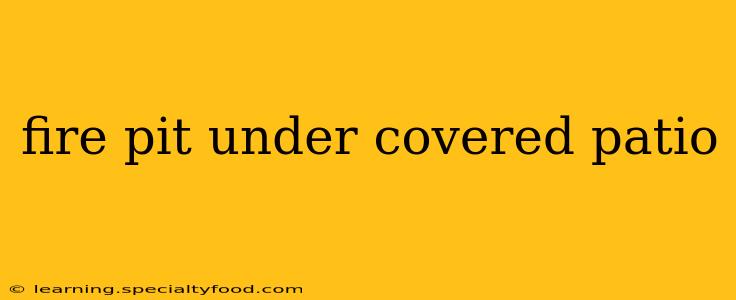Creating a cozy and inviting atmosphere under your covered patio is a fantastic way to extend your outdoor enjoyment. A fire pit adds warmth, ambiance, and a focal point to any patio space, but placing one under a covered structure requires careful consideration of safety and building codes. This comprehensive guide will explore the possibilities, challenges, and crucial factors to ensure you create a stunning and safe fire feature.
Is it Safe to Have a Fire Pit Under a Covered Patio?
This is the most crucial question, and the answer is: it depends. The safety of a fire pit under a covered patio hinges on several factors, primarily the type of fire pit, the materials of your patio cover, and adherence to local building codes and fire safety regulations. Many municipalities have strict rules about open flames near combustible materials. Before you even consider purchasing a fire pit, contact your local building department to inquire about regulations and obtain any necessary permits.
What Types of Fire Pits Are Suitable for Covered Patios?
Not all fire pits are created equal when it comes to covered patio installations. Here's a breakdown of the safest options:
-
Propane Fire Pits: These are generally considered the safest option for covered patios. They offer controlled flames and don't produce embers or sparks that could ignite surrounding materials. They also provide easy on/off functionality and consistent heat.
-
Natural Gas Fire Pits: Similar to propane, natural gas fire pits offer controlled flames and are a cleaner burning option. However, they require professional installation to connect to your gas line.
-
Electric Fire Pits: These are another safe alternative. They produce heat and a flame-like effect without an actual open flame, eliminating fire hazards. They are also incredibly easy to install and use.
Fire pits that should be avoided under covered patios: Traditional wood-burning fire pits present significant fire hazards under covered structures due to embers, sparks, and the potential for smoke buildup. Open flames in close proximity to combustible materials (like wood, fabrics, and even some roofing materials) are extremely dangerous.
What are the Building Codes and Safety Regulations for Fire Pits?
Building codes vary significantly by location. It's imperative to check with your local fire marshal or building department before installing any type of fire pit. Common regulations address:
- Clearance: Minimum distances between the fire pit and combustible materials (walls, roof, furniture) are usually specified.
- Ventilation: Adequate ventilation is necessary to prevent smoke buildup and potential carbon monoxide poisoning. This often involves requirements for open sides or specific venting systems.
- Fire Suppression: Easy access to fire extinguishers or other fire suppression systems is frequently mandated.
- Permits: You may need to obtain permits before installing a fire pit, particularly if it involves gas lines or significant construction.
What Materials Are Best for a Covered Patio with a Fire Pit?
Choosing fire-resistant materials for your patio cover is essential. Consider:
- Metal Roofing: Metal roofs are highly resistant to fire and offer excellent durability.
- Concrete Patio: Concrete is non-combustible and provides a stable base for your fire pit.
- Fire-Resistant Fabrics: If using fabric elements in your patio cover, ensure they're treated with fire-retardant chemicals.
Avoid using readily combustible materials like wood or vinyl siding near the fire pit.
How Can I Ensure Proper Ventilation When Using a Fire Pit Under a Covered Patio?
Adequate ventilation is crucial for safety. This can be achieved through:
- Open Sides: Designing your patio cover with open sides allows for good air circulation.
- Venting Systems: Some patio covers incorporate ventilation systems to draw smoke and fumes upward and away.
- Exhaust Fans: Consider installing exhaust fans to improve air circulation and remove smoke.
Can I Use a Wood-Burning Fire Pit Under a Pergola?
Generally, no. Pergolas, with their open latticework structures, are inherently more susceptible to fire damage than other types of patio covers. The risk of embers and sparks igniting the wood structure is too high. Propane or electric fire pits are much safer alternatives.
What are the Best Practices for Safe Fire Pit Use Under a Covered Patio?
- Never leave a fire unattended.
- Keep a fire extinguisher readily available.
- Have a plan for extinguishing the fire quickly and safely.
- Keep children and pets away from the fire pit.
- Be mindful of wind conditions. Strong winds can spread embers and create a fire hazard.
- Regularly inspect your fire pit and surrounding area for damage or hazards.
By carefully considering these factors and adhering to safety regulations, you can enjoy the warmth and ambiance of a fire pit under your covered patio while prioritizing safety and peace of mind. Remember, consulting with professionals—including building inspectors and fire safety experts—is always recommended for any project involving open flames near a structure.
